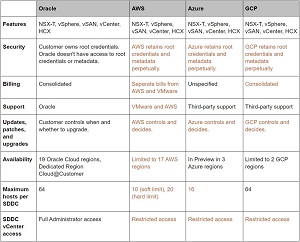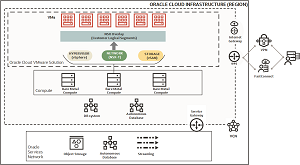News
Oracle Cloud VMware Solution Unveiled
VMware virtualization solutions continue to expand in the public cloud space, as Oracle announced a new VMware solution on its cloud platform, following other major providers including Amazon Web Services (AWS), Google Cloud Platform (GCP) and Microsoft Azure.
The web site for the new solution says it provides a customer managed, native VMware-based cloud environment, installed within a customer's tenancy and offering complete control using familiar VMware tools with which organizations can move or extend VMware-based workloads to the cloud without rearchitecting applications or retooling operations.
And, while the aforementioned "big 3" cloud providers are larger and have more established VMware solutions, Oracle claims its new offering is unique in that "it's just VMware," with no differences between on-premises and Oracle Cloud implementations.
"To offer a true VMware environment, the engineers at Oracle Cloud Infrastructure built Layer-2 network support into our virtual cloud network (VCN)," Oracle said in an August 5 blog post. "We set out to add native Layer-2 capabilities in our overlay network without the need for dedicated switches, racks, cages, or data centers. That meant we had to tackle the complex issues of network scale, multiple traffic paths, and the convergence times of Layer-2 overlay networks. The result is that we have an overlay network that supports VMware 'as is' with Oracle Cloud Infrastructure's cloud scale and performance."
The differences between the Oracle solution and the AWS/GCP/Azure triad's offerings are illustrated in this graphic, the company said:
 [Click on image for larger view.] VMware Cloud Comparison (source: Oracle).
[Click on image for larger view.] VMware Cloud Comparison (source: Oracle).
Oracle said it created the solution with three core use cases in mind:
-
Data center migration: Move workloads from on premises to Oracle Cloud VMware Solution as part of a broader effort to consolidate or decommission data centers.
-
Hybrid Deployments: Let customers selectively move and extend existing workloads to Oracle Cloud Infrastructure while leaving other workloads in place for various business or regulatory reasons.
-
Disaster recovery: Enable customers to reduce or remove reliance on secondary, typically underutilized, data centers for disaster recovery targets, potentially improving recovery time objective (RTO) and recovery point objective (RPO) targets.
 [Click on image for larger view.] Oracle Cloud VMware Architecture (source: Oracle).
[Click on image for larger view.] Oracle Cloud VMware Architecture (source: Oracle).
In view of those three core use cases, Oracle listed the highlights of the release as:
- Ease of migration -- Move VMware-based applications to Oracle Cloud without having to modify them; avoid effort spent porting applications, refactoring code or resolving configuration differences
- Delivered in your tenancy -- Customers control access and management services completely
- Unified commercial terms -- One contract for all services and can be used to meet existing universal commercial commitments
- Unified support -- Oracle provides one stop support for the entire tenancy, including VMware service support
- No retraining required -- Leverage existing software, skillsets and tools organizations are already using on-premises, including vSphere, vCenter, vSAN, and NSX
- Extend VMware environments to the cloud -- Configure a cloud environment to match on-premises and keep them in-sync; Oracle supports vSphere versions 6.5 and 6.7
- Use VMware validated solutions –Instant support for thousands of VMware-Ready applications, including popular third-party management tools
- Disaster recovery where needed -- Replicate or back-up into any commercial or government Oracle Cloud Region across the globe
- Total control -- Full administrative control over the VMware environment in the customer tenancy, such as version control of vSphere, access to host operating systems and all other on-premises administrative rights
- Powerful hardware -- Compute instances provide customers with 156 cores in three nodes to start, scaling to 64 nodes per cluster across multiple clusters, delivering the enterprise scale needed for VMware solutions in the cloud
Oracle, which last year announced a hybrid cloud partnership with VMware, was late to the VMware public cloud party when compared to AWS, GCP and Azure.
In May, for example, we announced that GCP played catch-up to AWS and Azure with its new offering, the fully managed Google Cloud VMware Engine service, which lets enterprises run VMware workloads natively on Google Cloud.
And just shortly before that, Microsoft announced its own Azure VMware solution preview, which lets organizations run VMware workloads natively on Azure.
However, AWS boasts the most mature solution, as years earlier VMware teamed up with AWS for a "VMware Cloud on AWS" solution.
About the Author
David Ramel is an editor and writer at Converge 360.